The Intel SSD 660p SSD Review: QLC NAND Arrives For Consumer SSDs
by Billy Tallis on August 7, 2018 11:00 AM ESTAnandTech Storage Bench - The Destroyer
The Destroyer is an extremely long test replicating the access patterns of very IO-intensive desktop usage. A detailed breakdown can be found in this article. Like real-world usage, the drives do get the occasional break that allows for some background garbage collection and flushing caches, but those idle times are limited to 25ms so that it doesn't take all week to run the test. These AnandTech Storage Bench (ATSB) tests do not involve running the actual applications that generated the workloads, so the scores are relatively insensitive to changes in CPU performance and RAM from our new testbed, but the jump to a newer version of Windows and the newer storage drivers can have an impact.
We quantify performance on this test by reporting the drive's average data throughput, the average latency of the I/O operations, and the total energy used by the drive over the course of the test.
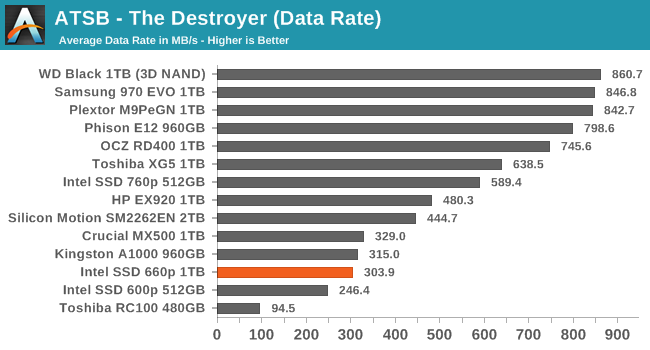
The Intel SSD 660p manages an average data rate on The Destroyer that is only slightly slower than the Crucial MX500 mainstream SATA SSD and the Kingston A1000 entry-level NVMe SSD. It's a step up from the performance of the 512GB Intel SSD 600p, and more than three times faster than the DRAMless Toshiba RC100.
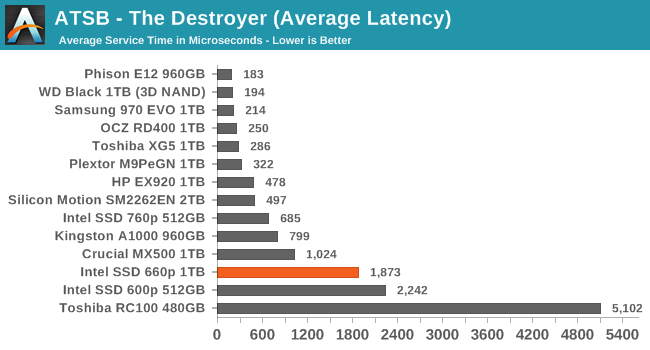
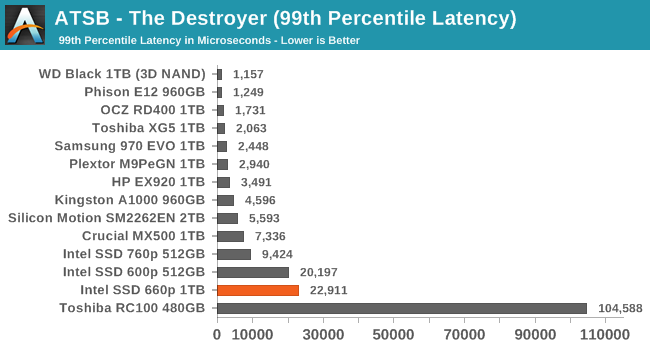
The average and 99th percentile latency scores for the Intel SSD 660p are quite poor by NVMe standards and significantly worse than the Crucial MX500, but the latency isn't completely out of control like it is for the Toshiba RC100.
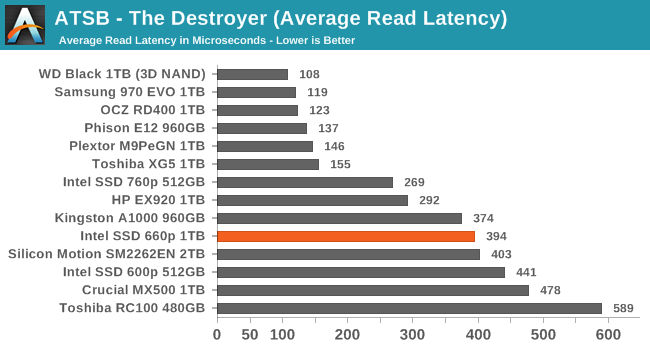
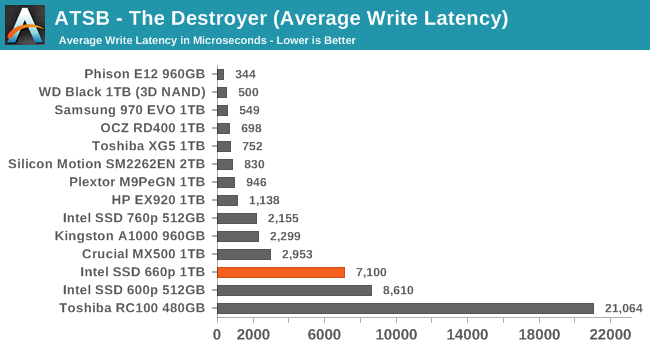
The average read latency from the 660p during The Destroyer is comparable to other low-end NVMe SSDs and better than the 600p or Crucial MX500. The average write latency is more than twice that of the MX500 but lower than the 600p and RC100.
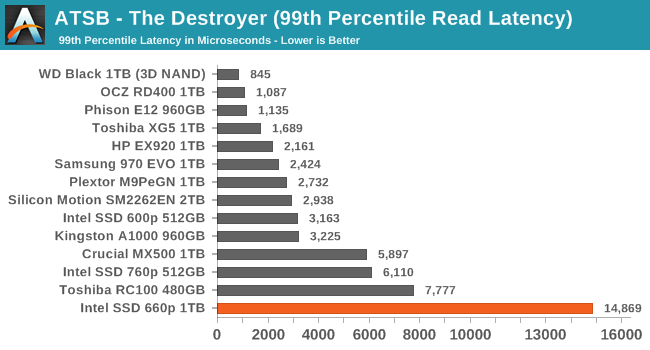
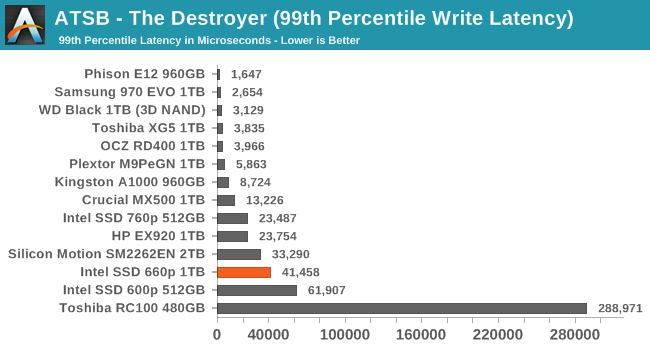
The 99th percentile read latency from the Intel SSD 660p on The Destroyer is significantly worse than any other NVMe SSD or the Crucial MX500 SATA SSD, but the 99th percentile write latency is an improvement over the 600p and does not show the extreme outliers that the Toshiba RC100 suffers from.
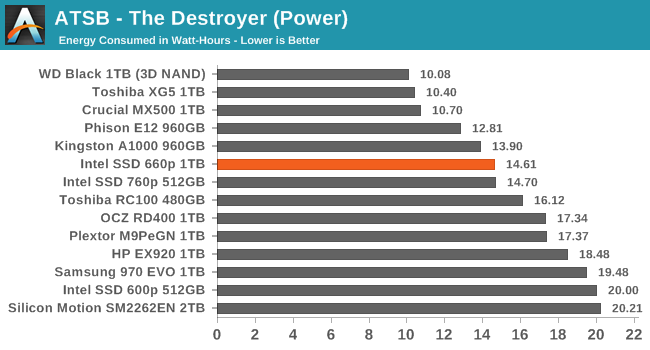
The energy usage of the 660p during The Destroyer is a bit better than average for NVMe SSDs, though still quite a bit higher than is typical for SATA SSDs. The 660p is less power hungry than most NVMe drives and slower, but not enough to drag out the test for so long that the power advantage disappears.










86 Comments
View All Comments
mapesdhs - Wednesday, August 8, 2018 - link
If you have quite literally "valuable info" then don't use a consumer SSD at all. Heck, damn the speed, you're far better with even a used 840 Pro. That's why I obtained one for this build I did, along with an SM951 for a scratch video drive:http://www.sgidepot.co.uk/misc/charitypc1.html
BurntMyBacon - Wednesday, August 8, 2018 - link
First point of interest is always have a backup plan. If information is valuable, don't rely on any single copy of it.As to your question of endurance, I don't think most personal use cases are likely to have an issue. If you have a professional workload, get a professional drive. The 840 Pro that mapesdhs keeps evangelizing is actually a pretty good option, though a Pro series (MLC) nvme drive will provide better performance while still providing endurance is the same ballpark as the 840Pro.
As to whether it will refresh the cell if powered on, I would expect most Samsung drive will, though it is not known whether
BurntMyBacon - Wednesday, August 8, 2018 - link
As to whether it will refresh if powered on, I don't believe that Samsung flash required the refresh cycle once the moved to 3D NAND with a larger feature size. That said, since QLC halves the voltage swing (and corresponding charge) vs TLC, it is likely that Samsung will need to do something to prevent voltage drift. This may not necessarily require active refreshing, though. It is not known (by me) whether this is a requirement for other manufacturer's 3DQLC NAND either.BurntMyBacon - Wednesday, August 8, 2018 - link
I get why they don't want an edit feature, but would it really hurt if they added a time limited recall type edit feature for when you fat thumb a hot key that posts your unfinished message before you are done with it. Maybe give you five minutes after a post initiate the edit to catch typos or grammar issues. It wouldn't really be enough to alter a conversation as it is unlikely that others will have responded within this time frame.AbRASiON - Tuesday, August 7, 2018 - link
Considering the abysmal performance of this thing, I think you really need a $/GB chart on the page and it would be nice to put in a very fast, modern hard drive. Something huge and 7200RPM with a lot of cache on it.Just to put it in perspective, because as it stands, wow this thing looks terrible. I expect VERY cheap prices if they're gonna run like this.
Oxford Guy - Tuesday, August 7, 2018 - link
No matter how terrible QLC is it is going to succeed in the market because consumers respond well to big and cheap.So, I think one interesting question is going to be how much disguising there will be of products having QLC. Microcenter, for instance, is apparently selling a TLC Inland drive, calling it MLC.
piroroadkill - Wednesday, August 8, 2018 - link
That's how I want QLC drives to be compared - to the best hard drives people might actually buy today to store their games on, for example.I'd love a cheap and large 4TB drive for my games, but it has to be both much faster than the HDD setup I use for games (2× 2TB 3.5" Seagate Hybrid drives in RAID0) and not too far off the same price.
zodiacfml - Wednesday, August 8, 2018 - link
Impressive performance. Easily beats my SATA 850 EVO in performance and twice the capacity I bought last December for the same price.There should be no reason for notebook manufacturers to settle for HDD except the cheapest laptops.
mapesdhs - Wednesday, August 8, 2018 - link
Given the 850 EVO's strong reliability reputation though, I wouldn't be overly eager to recommend this new QLC model for anyone wanting a decent degree of confidence that their data is safe. But then, most consumers don't have backup strategies anyway. :DSpunjji - Wednesday, August 8, 2018 - link
If you want safe data, make regular backups. Anything else is a false sense of security!